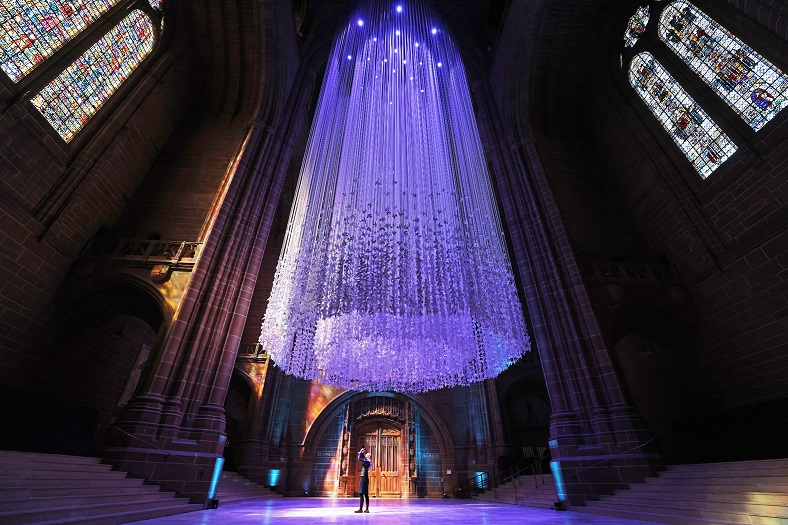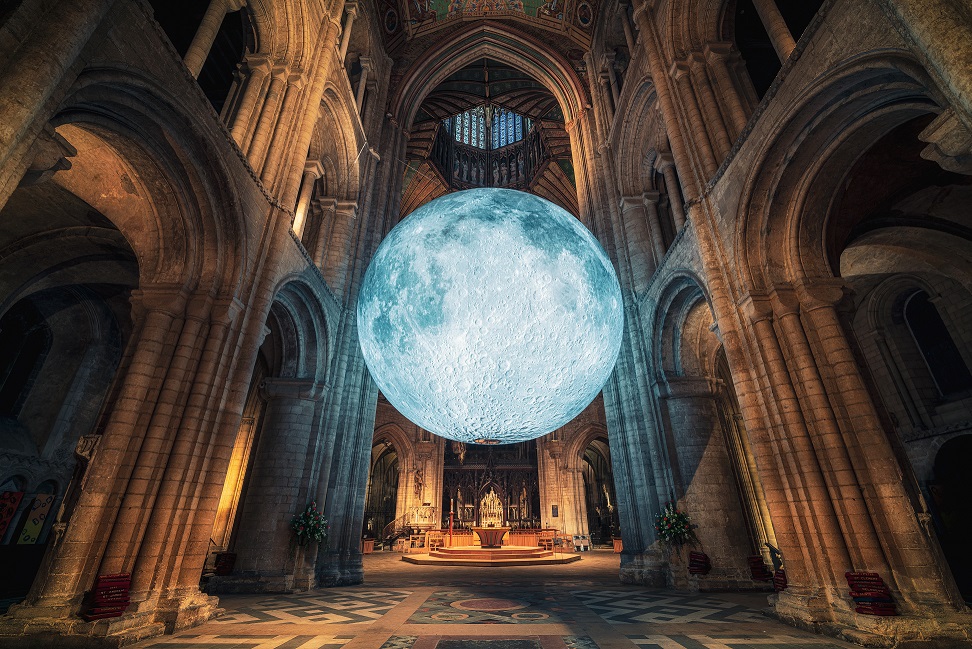Church Art
Jessica Tooze
‘Space, the Universe and Everything’ son et lumière at Liverpool Cathedral 2022 (Photo: Luxmuralis)
Churches and many of the UK’s cathedrals face a significant challenge addressing falling visitor numbers and the changing demands of the communities they serve. This change was brought into acute focus by the pandemic, when Anglican cathedrals in England saw a 75 per cent drop in visitors 1, a fall in worshippers and an 80 per cent decrease in income from the use of their facilities. Breathing new life and meaning into the treasured spaces of Britain’s religious landscape demands significant thought, sensitivity and creativity, and two exhibitions provide examples of how this can be achieved.
Art studio Luxmuralis is a collaborative team developing sound and light exhibitions, projecting large and intricate displays onto the walls and ceilings of cathedrals. Under the direction of artist Peter Walker, with music by David Harper, these shows of light, colour and sound lead visitors on a sensory tour through the interior of a cathedral, where multiple layers of art and music combine to create an immersive experience.
Walker has held a lifelong interest in art, developing an interest in fine art at the age of 20 and beginning his artistic career in religious buildings as Artistic Director and Artist in Residence at Lichfield Cathedral, roles he held for seven years. At Lichfield he was allowed broad artistic licence giving him a ‘blank space’ to work in, and after creating several projects, including a bronze statue of St Chad, he began to tour other cathedrals. As well as the light shows created under Luxmuralis, Walker creates major installations as a solo project, including the majestic ‘peace doves’ at Liverpool Cathedral.

Peace Doves installation by sculptor Peter Walker at Liverpool Cathedral (Photo: G Jones)
Each building is given a tailored display, with artworks being re-curated to fit their individual dimensions and needs. At the time of interviewing, Luxmuralis had recently completed shows in St Albans, Salisbury and Exeter. Looking forward, Luxmuralis are planning to roll out the installations to churches in smaller spaces, and the studio receives requests on a weekly basis from churches asking them to come and visit. While sites can apply for sponsorship, the shows are funded largely by ticket sales, and with the large number of visitors who attend, each show has the potential to raise essential funding for the host site.
While the projections extend into the far reaches of a cathedral’s space, there is no interference with the historic interior of the building, which is fully protected during setup and execution of the exhibit. No new fixings are made into historic fabric, and no materials are used that would leave harmful residues on the stonework or surfaces.
Historically, churches and cathedrals have always been used for the display of art, including the work of the finest craftspeople and artists of their period. The colour and light of Luxmuralis exhibitions are intended both as a modern-day tribute and historic link back to the painted ceilings and stained-glass windows of churches and cathedrals as they would have been prior to the Reformation. Prior to modern technology and mass literacy, congregations throughout history revered and relied on the images and stories found in the stained glass and painted images of their local churches.

‘The Beginning’ son et lumière at Sheffield Cathedral (Photo: Luxmuralis)
Evoking these medieval forms of messaging are what Walker calls ‘reanimation’: re-animating the space and its architecture in a contemporary way to say something about the world we live in. Subjects of the exhibits include space exploration, the fragility of the planet, science and the Renaissance. Exeter Cathedral’s exhibit, entitled simply ‘Life’ included illuminated texts by Charles Darwin and his grandfather Erasmus, with passages from the Origin of Species prominently displayed on the far nave wall.
Links to science and the natural world in a religious space, according to Walker, reflect the increasing talk in cathedrals around nature and sustainability, and the importance of these messages and stories being told. This has the potential to gift these historic spaces with a new purpose of building and supporting links and understanding between their communities and the world we inhabit. Such a purpose is precisely the aim of the Luxmuralis project and one which could help sustain the meaning of these buildings as the needs and desires of their respective communities evolve.
Smaller churches can also see a major benefit to hosting art exhibitions, given the clear opportunity to draw numbers and encourage a diverse mix of visitors across age and faith groups. St John the Baptist Church in Shepherd’s Bush hosted the Museum of the Moon exhibit in August 2021. Part of the Kensington and Chelsea Festival, the event saw the Grade I listed site welcoming 18,000 visitors over the 13 days the exhibit was in place. While the event was free to attend, over £4,000 was raised in donations.
The Museum of the Moon exhibit was created by artist Luke Jerram as an internally lit spherical sculpture of the moon, measuring seven metres in diameter. The sculpture displays NASA imagery of the lunar surface at 120dpi, with an approximate scale of 1:500,000, each centimetre representing 5km of the moon’s surface. The exhibit is accompanied by surround sound melodies composed by Dan Jones, who has worked with Jerram for over 15 years. Jerram feels that the surround sound composition helps connect the sculpture of the moon with the surrounding architecture: “For me, the music in the space shapes the atmosphere of the experience [and] guides the interpretation of the artwork.”

Museum of the Moon by Luke Jerram, Bristol Cathedral (Photo: Bob Pickford)
The concept of combining the moon exhibit with music was extended by St John’s to include two services during the event: ‘Moon Sung’ Eucharist and Evensong drew audiences of up to 150 people. The church also hosted a piano recital with voice accompaniment during the exhibit. Reverend Neil Traynor, Associate Priest at the Holland Park Benefice said: “It was standing room only with an entirely new audience being introduced to classical music to rapturous applause and hugely positive feedback.”
It is the inclusive, welcoming nature of the exhibits alongside the obvious draw of their beauty, that brings people of all ages and backgrounds into religious spaces they may never normally visit. Luke Jerram offers that “different cultures around the world have their own historical, cultural, scientific and religious relationships to the moon”, and it is clearly a universal symbol that people from all sections of society and across cultures can connect with. The installation at St John’s attracted, members of the Muslim, Sikh, Jewish, Hindu and Christian communities, including teenagers and young families. There were many conversations about the building and its decorative scheme and many positive comments about the church itself. Many visitors fed back that they had passed the building for years and had never been inside, had thought it closed or had no idea what was inside the building. Others said they could not believe how amazing it was.

Museum of the Moon by Luke Jerram, Ely Cathedral 2019 (Photo: James Billings)
Social media plays a key part in attracting visitors to exhibits in historic places of worship. Their striking visual qualities lend themselves easily to Instagram. The moving images of Luxmuralis are perfect for YouTube. Reverend Traynor reported that one TikTok video had over 40,000 views. Use of social media, and more importantly, the platforms that younger visitors are likely to use, is key to reaching a more diverse range of social groups.
Historic places of worship are often ideal places for art exhibitions and performances, particularly for music, light projections and large works of art. Secular events like these draw people together from a wider community, benefitting the congregation and the neighbourhood as a whole. From a religious perspective this is a crucial aspect of outreach, promoting involvement with the faith community and engagement with the place of worship on many levels, not least as a place of sanctuary, peace and quiet contemplation. From a conservation perspective, very few congregations are able to support the repair and maintenance of historic places of worship without the support of the local community too, and if the local community are already stakeholders in the use of the building, the burden of maintenance can be carried by far more people.
As we continue to emerge from the pandemic, and the threat of closure is increasing, there is greater urgency for the need to diversify, so churches can continue to be used as places of worship, if not exclusively. Many of our finest churches have a unique opportunity to pivot and offer something different, that speaks to all members of society. Housing artistic and musical exhibits that offer meaning to all is a unique way of celebrating the space they occupy, and the community who come to be part of them.



